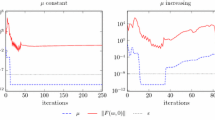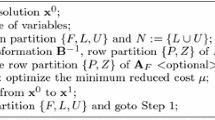Abstract
The Revised Primal Simplex algorithm, in its simplest form, has no defence against degeneracy. Various forms of the perturbation method are usually effective, but most offer no guarantee of avoiding all degeneracy, and can lead to numerical difficulties. This paper presents a method that avoids cycling and circling by taking a dual approach.
The degenerate subproblem consists of all the original variables, but only the degenerate transformed constraints. The current primal objective, which may be mixed, is used. This subproblem may be solved using the dual simplex algorithm, starting from the current dual infeasible solution, and with a zero dual objective. If the dual algorithm terminates optimally then the whole problem is optimal (subject to primal feasibility). Otherwise the final solution provides a non-basic direction which improves the value of the mixed primal objective and moves away from the degenerate vertex. A purification algorithm then renders the solution basic and further improves the mixed objective.
Similar content being viewed by others
References
D. Avis and V. Chvatal “Notes on Bland's pivoting rule,”Mathematical Programming Study 8 (1978) 24–34.
M. Benichou, J.M. Gauthier, G. Hentges and G. Ribiere, “The efficient solution of large-scale linear programming problems,”Mathematical Programming 13 (1977) 280–322.
R.G. Bland, “New finite pivoting rules for the simplex method,”Mathematics of Operations Research 2 (1977) 103–107.
A. Charnes, “Optimality and degeneracy in linear programming,”Econometrica 20 (1952) 160–170.
R. Fletcher, “Degeneracy in the presence of round-off errors,” Dundee University Department of Mathematical Science report NA/89 (1985).
J.J.H. Forrest and J.A. Tomlin, “Updated triangular factors of the basis to maintain sparsity in the product form simplex method,”Mathematical Programming 2 (1972) 263–278.
P.M.J. Harris, “Pivot selection methods of the Devex LP code,”Mathematical Programming Study 4 (1975) 30–57.
Scicon, “Sciconic/VM User Guide, Version 1.40,” Scicon Limited, Milton Keynes (1986).
P. Wolfe, “A technique for resolving degeneracy in linear programming,”Journal of the Society for Industrial and Applied Mathematics 11 (1963) 205–211.
Author information
Authors and Affiliations
Rights and permissions
About this article
Cite this article
Hattersley, B., Wilson, J. A dual approach to primal degeneracy. Mathematical Programming 42, 135–145 (1988). https://doi.org/10.1007/BF01589398
Received:
Issue Date:
DOI: https://doi.org/10.1007/BF01589398




